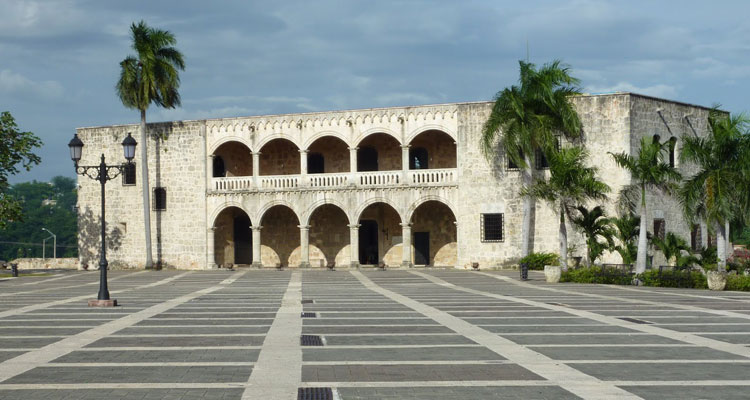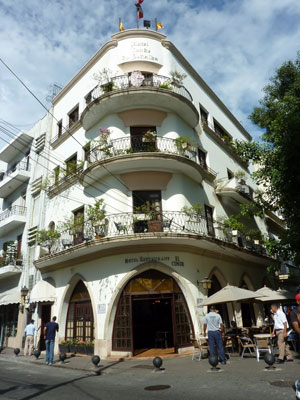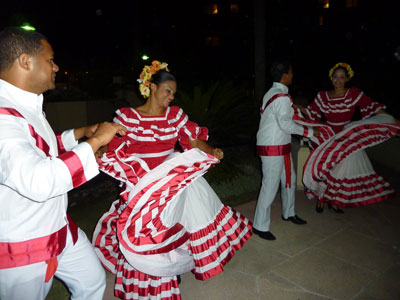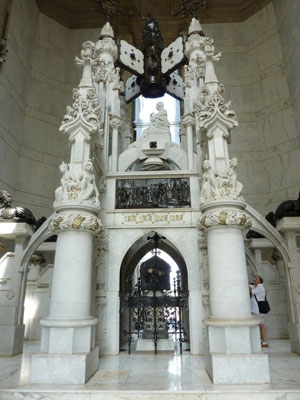An eye-opening introduction to the Dominican Republic’s capital city
by Judith Anshin, Contributing Editor
I have been to the Caribbean only once. It wasn’t a destination I usually thought of when planning a short trip, but that has changed now.
As a Contributing Editor for ITN, I attended the 17th Annual Florida Caribbean Cruise Association conference in Santo Domingo, Dominican Republic, in late October 2010. I joined a group of nine other travel writers for a jam-packed five days that left me wanting to return, especially to Santo Domingo’s Colonial Zone.
Our group had a private small bus and local guide, Carlos Batista (e-mail at carlosbat31@hotmail.com), allowing us to do individual activities away from the huge groups connected to the main conference.
Carlos is an outstanding guide. He speaks excellent English and has an encyclopedic knowledge of his country, its history and culture. He also knows the best local restaurants, so we had several memorable meals, and his energy and sense of humor helped make our long days most enjoyable.
For a city tour for one to five passengers with a car or bus, Carlos charges $40 per person. Visits to museums cost an additional $8 per person.
Santo Domingo
The modern city of Santo Domingo is orderly (well, maybe not the drivers), with broad avenues, many trees, greenery and seeming prosperity. Plaza de la Cultura (Cultural Square), near the center of the city, is a large park area with three museums, the national library and the national theater.
The land on which Cultural Square sits was once owned by the brutal dictator Rafael Trujillo, who ruled from 1930 until his assassination in 1961. It was “donated” to the public after his death.
The first metro in the city was opened in 2009 and a second line is being built. There are also two upscale malls; the Blue Mall is home to expensive retailers such as Louis Vuitton, Gucci and others.
Prices in the upscale restaurants in which we ate on a few occasions generally were in the $10-$15 range. The restaurants were bustling with locals.
While we saw little poverty, it certainly exists, and I understand that the divide between rich and poor there is wide.
Since the conference centered on the cruise industry, of great importance to the country, we visited the newly opened San Souci ship terminal, which is extremely large and quite attractive. Concerts and other events are held inside.
Across the river is the older Don Diego ship terminal, which can handle one ship at a time (San Souci can handle two). Both terminals are a short distance from the Colonial Zone, where I would recommend spending an entire day.
The Zone
The Colonial Zone is an 11-square-block UNESCO World Heritage Site that reflects much of the history of the country, from the Christopher Columbus family through Spanish and French rule.
The Zone has many, many small museums as well as the ruins of numerous firsts in the Americas: the first hospital, the first church and the first convent of the Dominican order. It also has several boutique hotels. While I did not see the guest rooms, the reception and garden areas were quite lovely.
The white church near the ruins of the first hospital is dedicated to Our Lady of High Grace, revered as the spiritual mother and protector of the Dominicans. The first hospital, next door, was built in 1503 with a floor plan in the shape of a cross. It survived earthquakes and hurricanes until 1911, when it was devastated by a hurricane. Much of what was left was knocked down to protect pedestrians, but Moorish arches and a few walls remain.
The Primate Cathedral of America, or Our Lady of Incarnation, is said to have had its first stone laid by Diego Columbus in 1521, but it wasn’t completed until 1540. Numerous architects worked on it through the years, which is why it has a Gothic vault, Romanesque arches and Baroque ornamentation. It is missing a steeple.
The interior has 14 chapels, each built by a separate family in a different style. It is quite beautiful.
Still a fully functioning church, it faces Parque Colón (more of a square than a park), which is surrounded by shops, hotels, restaurants and private homes.
Columbus’ son, Diego, and his wife, María de Toledo, lived in the Colonial Zone, and their modest palace, built in 1511, sits at one side of the Plaza de la Hispanidad. This large, open plaza also has restaurants nearby and a lovely, Renaissance-style building housing the Museo de las Casas Reales. The museum is also fronted by a large square, where we had a special dinner one evening. The front of the building was lit with various designs, and, in the warm evening air, it felt magical.
Columbus’ legacy
History tells us that Columbus stopped at the island of Hispaniola, which today contains the Dominican Republic and Haiti. His flagship, the Santa María, crashed into a coral reef, causing him to spend an extended period of time there. With salvaged wood from the ship, he built a fort and left some of his men behind while he returned to Spain, making several return trips.
It is said that in his will, he said he wished to be buried there. While Italy and Spain claim to have his remains, Dominicans believe his remains are currently interred in the Faro a Colón, or Columbus Lighthouse.
The lighthouse was completed in 1992, and Columbus’ beautiful, ornate tomb is housed there. Overhead, outlining the building’s cross-shaped roofline are 157 lights that shine skyward. These beams are so powerful that when they are turned on, the impoverished neighborhood nearby loses electrical power.
Along the length of the cross are rooms displaying items from many countries around the world. Also displayed are copies of Columbus’ writings and artifacts relating to him.
Although the lighthouse is unlike traditional lighthouses, it was very interesting.
Resort visit
On our last full day we traveled by bus to La Romana and the famous Caso de Campo resort, stopping en route at the Tobacco de Garcia cigar factory, said to be the largest in the world. When I heard about the planned stop, I was not very excited, but I found the visit fascinating.
We spent close to an hour seeing every stage of cigar making, from sorting and preparing the tobacco leaves to putting on the labels and boxing up the cigars.
Many of the machines used would certainly not pass OSHA regulations in the US, and some of the rooms had terrible air quality. Most of us had to cover our noses and mouths, marveling at how the workers had adjusted.
The enormous resort of Casa de Campo features a hotel; rental villas; a spa; two polo grounds; four top golf courses, and villas owned by wealthy individuals from around the world. Available activities include clay shooting; tennis; swimming; water sports; river and ocean fishing, and horseback riding.
The most amazing part of the resort is the Altos de Chavón, a re-creation of a 16th-century Mediterranean village. The idea of the village was to have an area where students could study with famous artists. In 1982, a 5,000-seat Grecian-style amphitheater was completed. Frank Sinatra was the inaugural performer, and many world-renowned artists have performed there over the years, including Andrea Boccelli.
The village is so accurate a re-creation of a Mediterranean village that many movies have been filmed there.
Dominican native Oscar de la Renta, who also built a home there, assisted in the original planning of Casa de Campo, contributing to the ambiance of the resort.
The resort would be a wonderful beginning or end to a cruise of the Caribbean. Room rates range from $295 to over $1,000 (the latter for a three-bedroom private villa). Altos de Chavón is open to the public, while the rest of the resort is reserved for its guests.
Direct flights are available from the US to La Romana’s international airport. The Dominican Republic has several international airports that serve the many resorts around the island, but I think the number of domestic flights needs to be increased.
While Casa de Campo is quite well known, many Americans don’t know much about the other attractions of the Dominican Republic. I felt as if I were seeing a country that hadn’t yet been deluged with tourists. The people were extremely friendly and hospitable to travelers, and prices were reasonable. It is a gem — one I will return to.
Judith was a guest of the Dominican Ministry of Tourism, with offices in Chicago, Miami and New York City (NYC; 888/374-6361).




